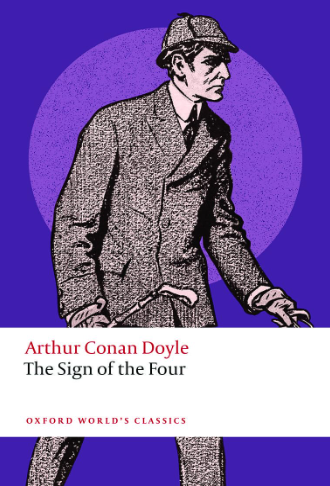Posted: March 25, 2022
The Sign of the Four

The Sherlock Holmes case in this book is connected with incidents during the time of the British Raj in India and includes an exotic trip to the subcontinent as well as a bracing chase in the Thames.
This second Sherlock Holmes story is just as good as the first.
It's amusing to note that at the end of "The Sign of the Four", Sir Arthur Conan Doyle seems to be writing Dr. Watson out of the Sherlock Holmes mysteries, since Watson gets himself into a marriage arrangement with the client, Mary Marston. I didn't know Watson was such a romantic.
In this story is also revealed that Holmes is addicted to both morphine and cocaine. According to him, he uses these substances to cope with the boredom between cases. It's something Watson frowns upon, to say the least.
During my review of "A Study in Scarlet", I commented on some cognitive science concepts that I got reminded of while reading the story. It's the same here. At one point, Sherlock Holmes was thinking about the case so intensely that he encountered a block that prevented him from going further. His answer is to divert his mind with another topic, in this case, chemistry.
Cognitive science makes the distinction between focused thinking and diffused thinking. When Sherlock was deep into the "The Sign of the Four" case, that was focused thinking. When he temporarily let go of the case and focused on a chemistry experiment, that was diffused thinking.
According to cognitive science, even if Sherlock wasn't actively thinking of the case his mind was still working actively on it on the subconscious level. And sure enough, when Sherlock finished with his chemistry experiment and went back to the case he made some breakthroughs.
I really like the backgrounders that Sir Arthur Conan Doyle provides for his Sherlock stories. They're like mini history lessons. In the previous story, "A Study in Scarlet", we got acquainted with the early history of Mormons in the U.S. Here we are given a glimpse of the Indian mutiny against the British Raj.
The case itself is fascinating. It begins with the disappearance of Mary Morstan's father, followed six years later by a series of "gifts" in the form of expensive pearls. When a letter arrived asking Mary for a secret meeting this is the time when she involves Sherlock Holmes. Events quickly escalate into a murder that is very exotically done. A fabulous treasure known as the Agra treasure is weaved around the tale.